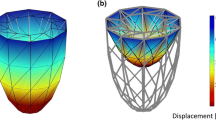Abstract
The exact mechanisms that cause myocardial stunning are still unclear. We previously utilized a computer model of the ventricle that was effective in modeling the dominant observable features of stunning, but it was not simple to implement. This led to the design of a single muscle fiber model. The mathematical model of a muscle fiber consisted of three elements: a contractile element, a series elastic element, and a parallel elastic element. The model created length waveforms based on time-dependent force and contractile stiffness functions. This model was initially evaluated by entering the same regional parameter values used in the global dual region ventricular model. First a reduction of the contractile stiffness function was applied by reducing the peak stiffness by 30%, and then the rates of activation and deactivation were reduced by 20% while maintaining the peak values constant. The three-element model produced results very similar to the canine and ventricular model. Thus, it is concluded that the simpler three-element model provides an accurate model of the myocardial tissue and its deficiencies during stunning.
Similar content being viewed by others
REFERENCES
Bolli R. Mechanisms of myocardial 'stunning.' Circulation 82: 723–738, 1990.
Bolli R, and Marban E. Molecular and cellular mechanisms of myocardial stunning. Physiol Rev 79: 609–634, 1999.
Brady AJ. The three element model of muscle mechanics: Its applicability to cardiac muscle. Physiologist 10: 75–86, 1967.
Brady AJ. An analysis of mechanical analogs of heart muscle. Eur J Cardiol 1(2): 193–200, 1973.
Braunwald E, and Kloner RA. The stunned myocardium: Prolonged, postischemic ventricular dysfunction. Circulation 66: 1146–1149, 1982.
Drzewiecki G, Wang J-J, Li J K-J, Kedem J, and Weiss H. Modeling of mechanical dysfunction in regional stunned myocardium of the left ventricle. IEEE Trans Biomed Eng 43: 1151–1163, 1996.
Fung YC. Comparison of different models of the heart muscle. J. Biomech 4: 289–295, 1971.
Heyndrickx GR, Millard RW, McRitchie RJ, Maroko PR, and Vatner SF. Regional myocardial function and electrophysiological alterations after brief coronary arterial occlusion in conscious dogs. J Clin Invest 56: 978–985, 1975.
Li J K-J. Regional left ventricular mechanics during myocardial ischemia. In Sideman S, Ed, Simulation and Modeling of the Cardiac System. Dordrecht, The Netherlands: Martinus Nijhoff, 1987, pp. 451–462.
Parmley WW, and Sonnenblick EH. Series elasticity in heart muscle. Its relation to contractile element velocity and proposed muscle models. Circulation Res 20(1): 112–123, 1967.
Sonnenblick EH. Series elastic and contractile elements in heart muscle: Changes in muscle length. Amer J Physiol 207: 1330–1338, 1964.
Wang X, Li G, Ren Y, Drzewiecki G, Li J K-J, and Kedem J. Mechanical restitution of contractility in stunned myocardium of open-chest dogs. Cardiovasc Eng 2: 57–66, 2002.
Author information
Authors and Affiliations
Rights and permissions
About this article
Cite this article
Scott, T., Drzewiecki, G., Kedem, J. et al. Can a Single Muscle Fiber Model the Features of Myocardial Stunning?. Cardiovascular Engineering 3, 31–38 (2003). https://doi.org/10.1023/A:1024746918908
Issue Date:
DOI: https://doi.org/10.1023/A:1024746918908




